Back in the ancient days of the mid-90s when I lived in Bradley Beach, New Jersey, I had a picture of Jack Kerouac on the wall of my apartment. Though I left New Jersey in a hurry when the time came to move on, I managed to grab that picture and hang it on the wall of the cabin I built near Hastings, Pennsylvania. When the frame fell to the floor one day, the glass shattered, and I don’t remember what happened to the picture after gravity took its course.
There are other Kerouac items I’ve lost or given away. I got my first copy of On the Road when I was fourteen or fifteen. I’d purchased it on a whim when Jack’s name showed up in a biography of Jim Morrison. The Doors were never really my thing, but when I was fifteen, I spent a lot of time educating myself about the finer points of rock and roll. Kerouac’s book, when I found it, was a revelation. That small paperback, with its very 1970s cover, disappeared in the years that followed, probably the victim of several relocations.
You don’t analyze your obsessions when you’re a teenager, and I couldn’t articulate why I loved On the Road or why I wanted (or needed) more Kerouac books. Jordan Peterson says the artist’s job is to live in the place that sits between our perceived reality and the world of dreams, the spiritual space that we can’t always describe. Several decades later, I can identify tenderness as the main ingredient in Kerouac’s novels. Books like Lonesome Traveler and Desolation Angels make me feel something that can only be described as mystical, and that’s precisely because of the author’s tender observations.
Reviewers who dismissed On the Road in 1957 ignored the tenderness that Jack Kerouac applies to America and Americans, a tenderness that no other writer has approached. As much as the novel is about movement and freedom, it’s really a love letter to America. America and its inhabitants are larger than life for Kerouac. When he hitches a ride with a truck driver, the man is “a great big tough truckdriver with popping eyes and a hoarse raspy voice who just slammed and kicked at everything.” He’s nearly a cliché: unafraid, boisterous, and in charge of his own destiny. He tells Sal (the book’s narrator, who is Kerouac’s persona), “Them goddam cops can’t put no flies on my ass.”
At the beginning of Chapter 4, Sal hitches another ride, and Kerouac writes, “The greatest ride in my life was about to come up” with Mississippi Gene and Montana Slim. In Nebraska, Sal sees a “rawhide old-timer Nebraska farmer” who has “the greatest laugh in the world.” The truck driver and Montana Slim are quintessentially American, and the reader can visualize them. Kerouac’s hyperbole never seems overwrought.
There is significant religious imagery in On the Road, too, perhaps because Kerouac doesn’t see a difference in how he considers Jesus or America—both are objects of his affection. Sal heads West for the first time early in the book, and as he approaches Denver—home to his friends Dean Moriarty and Carlo Marx—he imagines the excitement that awaits. He says of his friends, “In their eyes I would be strange and ragged and like the Prophet who has walked across the land to bring the dark Word, and the only Word I had was ‘Wow!’” One can imagine that for Kerouac the Roman Catholic, capitalizing Word is no accident: for him, beat was derived from beatific or the Beatitudes.
Sal and Dean have their eyes open to whatever the road might bring in ways of spiritual enlightenment—they’re looking to be fulfilled. Kerouac lamented that this side of his writing was overlooked. In 1968 he told William F. Buckley, “In the papers they called it ‘beat mutiny’ and ‘beat insurrection,’ words I never used. Being a Catholic, I believe in order, tenderness, and piety.”
The hoboes and migrant workers Sal encounters are otherworldly to him, and they represent an America that is disappearing. It is an older, more adventurous America that he seeks, peopled by individuals who exemplify an idea. Those who misunderstood Kerouac’s intent in writing On the Road had the loudest voices in the late 1950s, and the author often had to defend the book. As Howard Cunnell says, “His apparently out-of-nowhere emergence as the mythologizer and reluctant figurehead of a countercultural generation defined by opposition to cold war politics and ideology made him an open target.”
Kerouac’s friend William Burroughs said, “After 1957 On the Road sold a trillion Levis and a million espresso coffee machines.” Burroughs blamed the media, whom he called “arch-opportunists.” Kerouac didn’t set out to be anyone’s spokesperson, and he felt no affinity to 1950s juvenile delinquency or anyone who was “on the bum,” as one writer described him. Kerouac’s heroes weren’t violent, and his attachment to the countercultural movement of the 1960s was a reality he unhappily contended with. These connections distressed him. He told an interviewer in 1957, “Listen, I’m a railroad brakeman, merchant marine deckhand in war time. Beatniks don’t do these things. They don’t want to work. They don’t want to get jobs.”
There is excess and hyperbole throughout On the Road. There is joy and sadness, there is ecstasy in seeking, and there is disillusionment, too. The book is fast paced and kinetic, but the freedom of the road is illusory, and movement doesn’t leave Sal and Dean unencumbered. Near the end of the novel, Sal is sick with a fever in Mexico City, a victim of dysentery. Dean leaves Mexico City and a delirious Sal behind. Dean says, “Gotta get back to my life.” Sal is angry (he calls Dean a rat) but forgiving, and he says, “I had to understand the impossible complexity of his life.”
On the Road is probably my least favorite among Kerouac’s books, though that doesn’t diminish its power. I prefer The Dharma Bums, Lonesome Traveler, and Desolation Angels. In the latter two books, Kerouac writes about his work as a railroad brakeman, and about his time spent as a lookout for forest fires on a mountaintop in Washington state. What’s remarkable about these stories is that Kerouac never mentions the drudgery that work might bring; instead, he notes the glorious and complex humanity that is present in everything we do, the sadness and the joy, the aching reach for illumination.
Kerouac was an observer of the human condition, and an important one. His willingness to write about his own flaws and imperfections—to work toward the things rumbling around his unconscious mind and express them—is still relevant.
A lot of writers choose to focus on Kerouac’s bitter ending. He died mostly broke and ravaged by alcohol at the age of forty-seven. I prefer to remember Jack Kerouac as a lover of life, as a keen observer, as the strong and vibrant railroad brakeman in the picture that used to hang on my wall. You can see the brakeman’s manual in his pocket, and Kerouac seems to be gazing at all the excitement and tender gladness that life might bring
.
Gerry Stanek has written three books set in the coal fields of Western Pennsylvania. He publishes Notes from Plattsville semi-regularly via Substack and recently released an album of rock and roll songs that’s streaming everywhere. He lives in Greensboro, NC with his three daughters. Find him athttps://gerrystanek.com/





